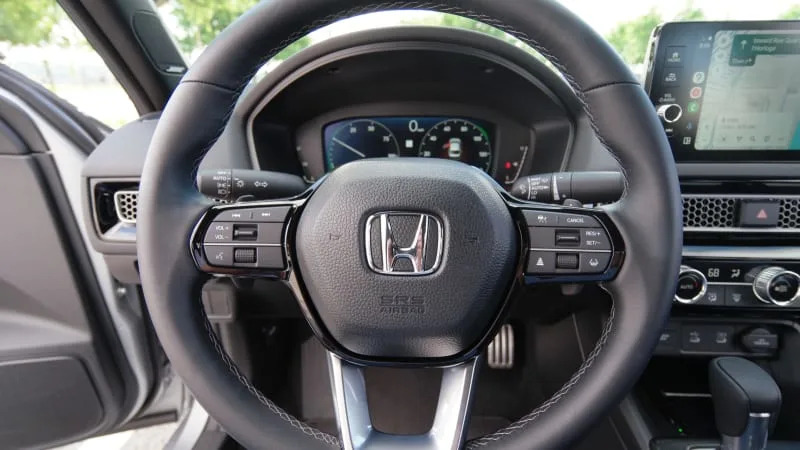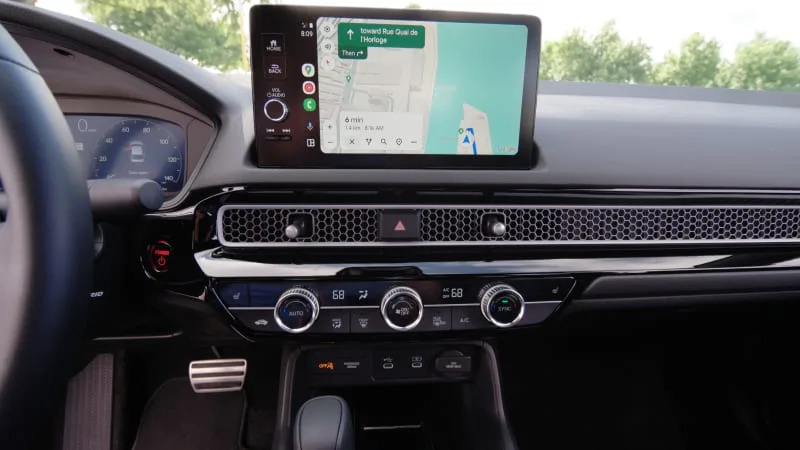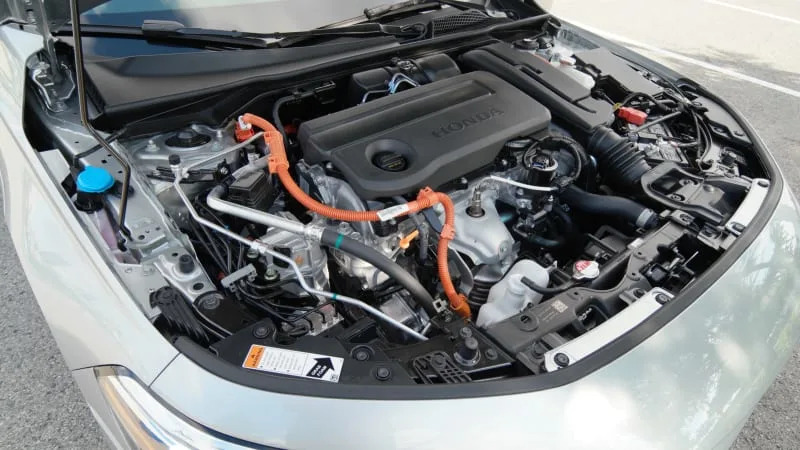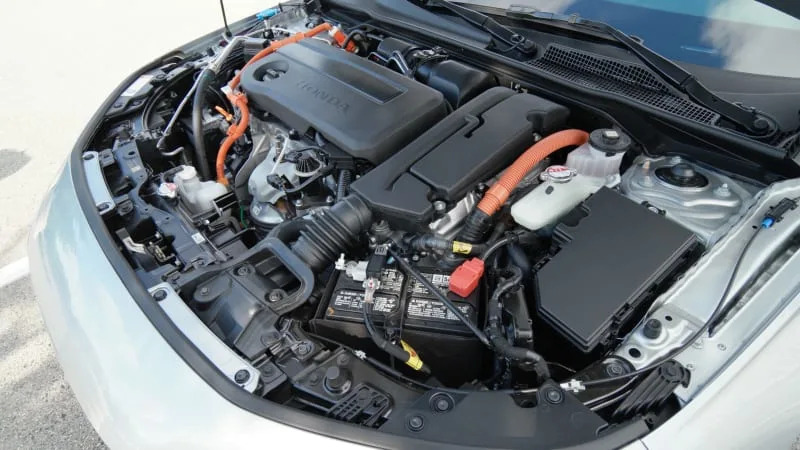2025 Honda Civic Hybrid First Drive Review: Leader of the pack

The Honda Civic may be one of the most ubiquitous cars on roadways across the United States. Seeing them so often could lull one into thinking of the compact car as little more than an appliance, an object to get from one point to another with as little fuss as possible. But that’s simply not the case with the Civic. It has consistently been one of the best cars for sale in America — a good reason why it’s proven so popular for so long — and the refreshed 2025 Honda Civic, particularly in the hybrid form we tested, may be the best all-around version yet.
The 2025 Civic’s single largest change for its mid-cycle freshening is the addition of a 2.0-liter four-cylinder hybrid powertrain with 200 horsepower that shares a lot with the hybrid available in the Honda Accord and CR-V. It also takes the place of the outgoing 180-hp, 1.5-liter turbocharged option. We loved the little turbo engine and will miss its hot-hatch-lite performance (not to mention the manual transmission that is also a goner), but we also think most drivers will be better served by the 200-horsepower hybrid replacement. It’s torquey, with a stout 232 pound-feet from 0 through 2,000 rpm spurred on by the electric motor and gearless eCVT transmission, but it doesn’t feel like it wants to live solely at low-rpm speeds when the driver calls up a heavy application of throttle.
Honda engineers tell us that the gasoline-fueled Atkinson-cycle engine doesn’t often put power directly to the wheels – it utilizes a high-speed lockup clutch at highway speeds for direct drive – but thanks to programming trickery, gearing and electricity from twin electric motors, it all just works in a shockingly seamless manner. We tested the hybrid in Econ(omy), Normal and Sport modes and found each of them well tuned for their respective purposes.
The default Normal mode is what we’d expect the majority of drivers to use, and it’s perfectly appropriate with linear throttle response and solid steering feel. Sport ramps up the throttle response and reduces steering assist (it also engages “Active Sound Control” for some additional auditory flair in the cabin and changes the digital gauges to a sportier look), and while the curviest roads we were able to drive during our two-hour stint behind the wheel in Montreal just prior to the Canadian Grand Prix were highway on- and off-ramps, it felt well-sorted for the task. Surprisingly, even Econ felt fine, eking out a bit more efficiency with smoothed-out throttle response and reduced use of the car’s air conditioning. The top-spec Sport Touring Hybrid gains an additional (new-for-2025) Individual mode that the driver can tailor to their liking.
The Civic Hybrid’s solid performance does not come at the cost of efficiency. It is expected to return 50 miles per gallon in the city, 47 on the highway and 49 combined. The Toyota Corolla Hybrid, which is the most logical competitor, gets 53/46/50 in LE trim or 50/43/47 in its sportier SE flavor. The Honda certainly feels much sportier from behind the wheel than the Toyota, earning it the nod as the driver’s choice between the two.
There are four levels of regenerative braking, switchable by using paddles to the left and right of the steering wheel. The default position — call it level 1, if you will — is basically none, while 2, 3 and 4 ramp up the regen in successive steps. Even at the most aggressive level, though, the 2025 Civic Hybrid doesn’t brake as hard as a fully electric car’s one-pedal driving mode, and it does not bring the car to a full stop.
All Civics get retuned springs and dampers and more rigid front upper suspension mounts, front subframe mount and rear lower suspension mounts. Hybrid models also benefit from a center of gravity that’s 10 millimeters lower than non-hybrids along with unique spring and damper tuning. The tires are said to have 19% less rolling resistance, but at the fairly sedate speeds we were forced to drive in traffic, we did not notice any reduction in grip.
Shoppers with a particularly keen eye may spot the 2025 Civic’s restyled grille and front fascia, which is joined by darker taillights and a blacked-out headlight reflector. The Civic Hybrid Sport benefits from more blacked-out bits and a body-color grille surround and front spoiler. To our eyes, it’s a sharp car in both sedan and hatchback forms, and yes, the hybrid powertrain is optional for both body styles.


On the inside, Honda blessed Sport Touring Hybrid models like our silver test car with a shiny new 9-inch touchscreen infotainment system that’s powered by Google Built-In and offers access to apps through the Play Store. It supports wireless Android Auto and Apple CarPlay, but its inclusion of Google Maps with live traffic as the native navigation system will offer a familiar interface to many users. It’s a slick system that is easy to use, moves through its motions quickly with no discernible lag and benefits from physical Home and Back buttons, a real volume dial and smaller forward and reverse buttons at the bottom below the volume. This marks the first time Honda’s latest infotainment package is offered in a Civic, and it’s certainly more desirable than the older 7-inch package in lesser trim levels. Hopefully, the new system proliferates down to the rest of the Civic lineup in the coming years.
The rest of the new Civic’s interior pretty much carries over from 2024. Our Sport Touring Hybrid test vehicle’s 10.2-inch digital instrument cluster is easy to read and generally mimics the traditional gauges of other Civic trims. The interesting mesh band that runs the width of the dash still houses the air vents, and while that’s pretty much the only visual flair to the Civic’s cabin, the design of everything is so harmonious, simple and effective that we really have no complaints. The new hybrid powertrain is available in both sedan and hatchback styles, and both are roomy enough inside for four adults and their luggage that it’s really the buyer’s choice of how they want their cargo capacity doled out.
The oddly named Honda Sensing safety package is standard across the Civic range, and it’s reportedly been refined for 2025 with Collision Mitigation tuned to better detect bicycles and motorcycles, offer Adaptive Cruise with smoother acceleration and deceleration and smoother Lane Keeping Assist.


While we didn’t test anything but the new Civic Hybrid sedan, a 2.0-liter four-cylinder remains the base engine in the LX for $24,345 and Sport for $27,345. Honda says it’s newly designed for ’25 to make 150 hp (down 8) and 133 lb-ft (down 5 but delivered earlier) and improve fuel mileage by between 1 and 2 mpg, depending on trim. The Sport Hybrid starts at $29,845. Stepping up to the Sport Touring Hybrid will ring the register to $32,845 and bring with it the aforementioned infotainment and digital cluster tech, leather seats, a Bose audio system and more. The sedan goes on sale as this story is published, with the hatchback following shortly thereafter.
The sporty Civic Si returns with its 1.5-liter turbo engine with 200 hp and 192 lb-ft for 2025. Note that the Civic Hybrid is technically the more powerful option, but the Si retains its six-speed manual, and the two models will deliver extremely different experiences from behind the wheel. We expect the top rung of the Civic ladder to remain occupied by the Type R and its 2.0-liter turbo engine’s 315 hp and 310 lb-ft.
As ever, there’s a Civic designed for just about every potential buyer. And while we love the feel of a small-displacement turbo sending its ponies through a proper manual gearbox, the new Sport Touring Hybrid strikes us as a nearly perfect balance of size, efficiency, performance, technology and value. We expect that buyers will flock to it in droves.





